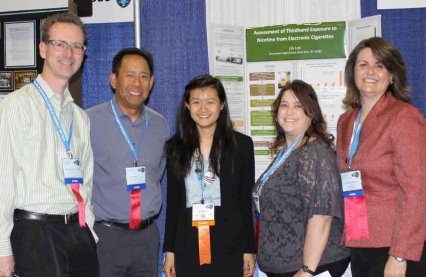An exploration of third-hand nicotine exposure from e-cigarettes was given the top Addiction Science Award at the 2014 Intel International Science and Engineering Fair (ISEF)—the world’s largest science competition for high school students. The awards are coordinated by the National Institute on Drug Abuse (NIDA), part of the National Institutes of Health, and Friends of NIDA, a coalition that supports NIDA’s mission. The Intel ISEF Addiction Science Awards were presented at a ceremony Thursday night at the Los Angeles Convention Center.
 First place winner of 2014 Addiction Science Award (from left to right): Judges and NIDA grantees Dr. Keith Heinzerling and Dr. Mitchell Wong, UCLA; winner Lily Wei Lee; Judge and NIDA grantee Dr. Bridget Freisthler, UCLA; and NIDA’s Dr. Sheri Grabus
First place winner of 2014 Addiction Science Award (from left to right): Judges and NIDA grantees Dr. Keith Heinzerling and Dr. Mitchell Wong, UCLA; winner Lily Wei Lee; Judge and NIDA grantee Dr. Bridget Freisthler, UCLA; and NIDA’s Dr. Sheri GrabusFirst place distinction was awarded to Lily Wei Lee, a high school senior at Stuyvesant High School in New York City for her project, Assessment of Third Hand Exposure to Nicotine from Electronic Cigarettes. The 18-year-old wondered whether e-cigarette use could pose a risk of third-hand exposure, where nicotine from vapors sticks to surfaces to affect non-users even if they aren’t exposed to the e-cigarette use. She took three brands of e-cigarettes and filled them with varying nicotine concentrations. Using a syringe to ensure consistent puffs, e-cigarettes were vaped, after which nicotine concentrations were measured from surrounding surfaces – a glass window, vinyl walls, tiled floor, metal, and wood. Lee found significant increases in the amount of nicotine on all five surfaces; the floor and window had the greatest nicotine levels. The amount of residual nicotine depended on the particular brand used. Lee hopes to next explore whether e-cigarette usage is also related to increased third-hand exposure to cancer-causing agents.
“This bright, young scientist showed that non-users can be exposed to nicotine residue from just one e-cigarette, even if the e-cigarette usage occurred some time ago,” said NIDA Director Nora D. Volkow, M.D. “Chronic e-cigarette use would be expected to produce even higher levels of third-hand nicotine exposure, and it’s unclear how such exposure could impact the health of close family members, friends, and coworkers who are regularly exposed to these environments.”
The second place distinction went to Aakash Jain, a high school senior at Brophy College Preparatory in Phoenix. His project, Computational Analysis of the GABA(A) Receptor, used computational and statistical techniques to provide insight into the three-dimensional structure of the GABA(A) receptor – which is believed to be involved in various disease conditions such as depression, schizophrenia, Parkinson’s disease, and addiction. After developing his model, Jain then screened approximately 2,500 drugs to determine if their structure would be a tight fit for the GABA(A) receptor. Through this process, Jain was able to identify several compounds that deserved further research into their possible clinical applications.
Winning third place distinction were two high school juniors, Alexandra Ulmer and Sarayu Caulfield from Oregon Episcopal School in Portland. Their project, Capacity Limits of Working Memory: The Impact of Multitasking on Cognitive Control and Emotion Recognition in the Adolescent Mind, explored whether experience with multitasking affected behaviors controlled by the prefrontal cortex, an area involved in self-control that is negatively impacted by drug use. They found that experienced multitaskers were better at multitasking, switching priorities, and filtering out distracting, irrelevant tasks. However, they were less able to focus on a single task, possibly because they are anticipating new information. These results may be especially relevant to today’s young, who are exposed to more streams of electronic information compared to previous generations.
Judges for this year’s Addiction Science Award included NIDA-funded researchers from the University of California, Los Angeles: Keith Heinzerling, M.D., Mitchell Wong, M.D., Ph.D., and Bridget Freisthler, Ph.D.; and NIDA’s Sheri Grabus, Ph.D.
The Friends of NIDA provides funding for the awards as part of its ongoing support of research into the causes, consequences, prevention, and treatment of drug abuse and addiction.
“These incredibly gifted, young students demonstrated innovation well beyond their years,” said William Dewey, Ph.D., president and chair of the Executive Committee, Friends of NIDA, as well as the Louis S. and Ruth S. Harris Professor and chair, Department of Pharmacology and Toxicology, Virginia Commonwealth University, in Richmond. “From looking at the effects of new technologies on health and cognition to computerized receptor modeling, this year’s winners covered a wide range of topics. We hope this award will encourage them to pursue a career in addiction science.”
This year, about 1,700 students from 70 countries, regions and territories participated in the Intel ISEF competition, coordinated by the Society for Science and the Public. The nonprofit organization partners with Intel—along with dozens of other corporate, academic, government and science-focused sponsors—to provide support and awards each year. Addiction Science Winners receive cash awards provided by Friends of NIDA, with a $2,500 scholarship for the first-place honoree. NIDA has developed a special section on its website, which includes other resources on addiction science, to highlight the winning projects and to help science fair entrants understand the criteria for the awards: The NIDA Science Fair Award for Addiction Science.
